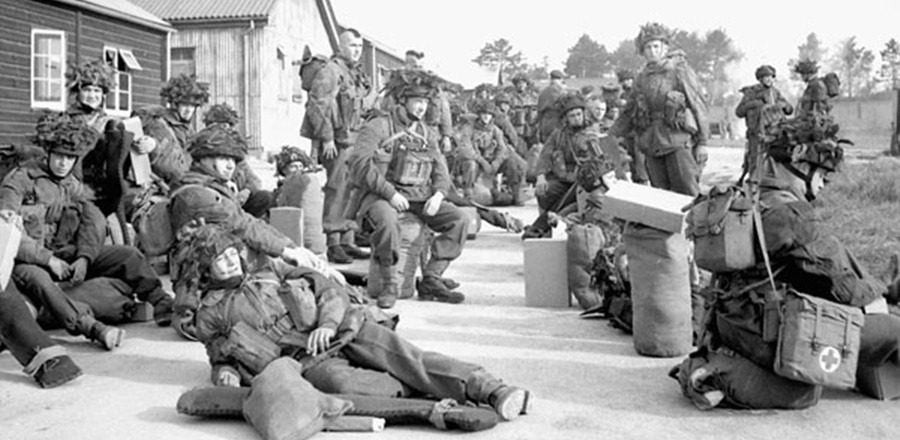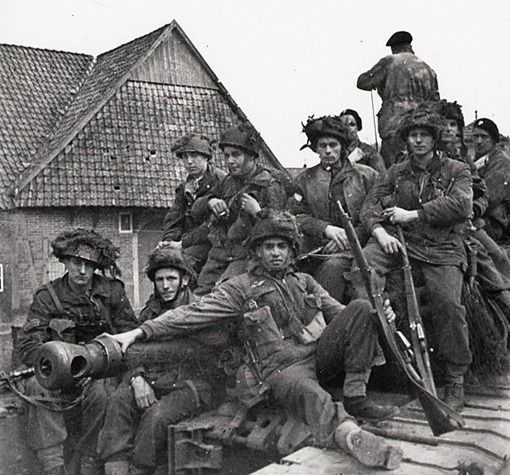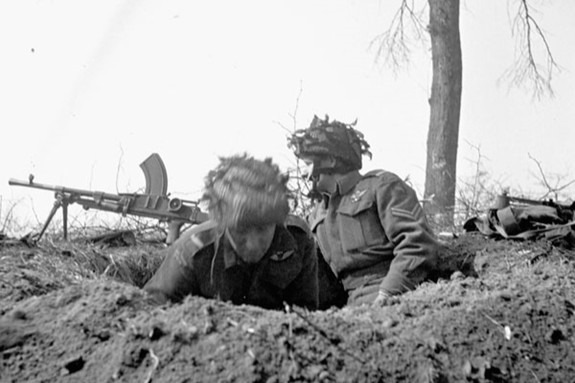Valour Canada
D-Day: 1 Cdn Para Bn’s Anderson
On June 5, 1944, shortly before midnight, nineteen-year-old Raymond Anderson landed in France. A member of the 1st Canadian Parachute Battalion (1 Cdn Para), Anderson had been sent in early to establish the Drop Zone in preparation for his battalion’s role in the D-Day landings. Chosen for the job because it was thought that his Aboriginal background would come in handy—he was Métis and extremely skilled in the art of concealment and bushcraft—Anderson’s task was essential for the success of the mission: to secure the eastern flank of the Normandy Coast where the D-Day invasion would take place. It was the 1st Canadian Parachute Battalion’s first combat mission.

Image 1: Paratroopers of the 1st Canadian Parachute Battalion in a transit camp staging area prior to D-Day, England, ca. 1-5 June 1944. (Credit: Sgt. Elmer R. Bonter/ Canada DND/ LAC PA-114599)

Paratroopers of the 1st Canadian Parachute battalion on a Churchill tank in early 1945. (Credit: Charles H. Richer/ Canada DND/ LAC PA-142610)
Despite Anderson’s preparatory efforts the follow-up parachute drop did not go according to plan. During the very early hours of June 6th the main force of thirty-six, paratrooper-laden, C-47 Dakota aircrafts approached the designated Drop Zone (DZ). Unfortunately, the Dakotas encountered German anti-aircraft gunfire, and they were forced to veer off course. Their detours, in combination with poor visibility, resulted in a situation in which the paratroopers who successfully made the drop found themselves scattered across an area much larger than expected, some of them kilometers away from Raymond Anderson and the DZ that was established by him and his team earlier that night. Eighty-two paratroopers from the main drop were captured by German forces before making it to the DZ while some of those who landed in flooded marshland were drowned by the weight of their equipment (note the postures in image 1).
Due to these difficulties only a third of the battalion reached their rendezvous points. Once there, the paratroopers realized that most of their equipment, including their heavy weaponry and explosives, had been lost during the mission. Nonetheless, the paratroopers managed to capture all their objectives and successfully prevented German reinforcements from reaching the beaches and thereby contributed to the Allies’ dramatic victory.
“Andy” survived the Second World War, went on the serve in Korea, lived a long and fruitful life as an employee of the Province of Manitoba, and passed in 2016. Read his In Memoriam HERE.
For another article on our Parachute Battalion on D-Day, see 1 Cdn Parachute Bn’s McLeod. To learn more about the 1st Canadian Parachute Battalion, visit the Juno Beach Centre.
Valour Canada is a Calgary-based non-profit, which educates young Canadians about our country’s military history. In 2024, Valour Canada spoke to over 5,600 students in classrooms or museums in Alberta and Ontario. The article above is one of over 280 within Valour Canada’s online Canadian military history library. The organization also has a sizeable Resources Section, Virtual Tours, and a YouTube channel with short documentary videos. In addition, the organization holds an annual scholarship contest for Gr. 12s who can show by summer’s end that they have been accepted to a post-secondary educational institution (2025 Deadline: June 11th).

